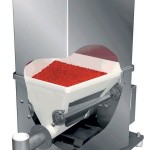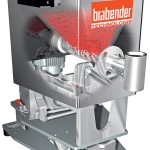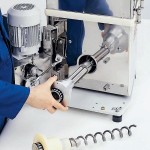Flexwall Plus feeders are designed to deliver a true mass flow particularly effectively, due to their trapezoidal design with side walls tapering in the conveying direction to produce countless different flow angles. The integrated ISC Plus control module allows connection to almost any automation system. Wireless communication with higher-level systems is also possible.
Rolf Welsch
Continuous feeding of powders to processing machines such as extruders, kneaders, blenders, etc. places high demands on the feeding consistency of the feeder technology employed, as this is a key factor in determining the quality of the final product. One reason are the very diverse flow properties of the bulk ingredients, which can be bridging, sticky or fluidising. A true mass flow in the feeder is thus essential for handling bulk ingredients. There are various strategies for this purpose, such as a stirrer or external massage paddles. Walls of varying steepness contribute significantly to improving mass flow in the feeder. This is what prompted Brabender to develop the Flexwall feeder principle with flexible hopper and external massage paddles about ten years ago. The Flexwall Plus combines two advantages. Its trapezoidal design effectively delivers a true mass flow. The side walls tapering in the conveying direction produce countless different flow angles. The trapeze shape also allows a space-saving circular arrangement above processing machines. Angles of about 60° (integer fraction of a circle) provide a basic configuration for six weigh-feeders in a circular set-up. It is even possible to install nine feeders, since in practice their screw outlets do not reach into the centre of the circle. These are only two of the many features that resulted in the patent a decade ago.
Design advantages
The advantages of the Flexwall Plus variants complement the features already familiar from other feeders with flexible walls. The feed screws are always located at the lowest point of the hopper to prevent the formation of a mechanical bridge above them. Agitation is much more intensive in the entire area around the screws, as the flexible hopper also induces a motion on the screw sides. This is not possible with an agitator arranged above the feed screws. Screw feeder refill problems are reduced as a result. For the same reason, only minimal residues remain in the hopper in case of changes in the production process. The paddle agitation frequencies and amplitudes are adjustable. In order to achieve the same effect with an agitator, it would at least need to be speed-controlled. The cross-sectional areas of the flexible hopper inlets, which are 200 % larger than classic agitator hoppers, prevent the formation of bridges directly above them. The free bridge length, which is necessary to avoid accumulations of bulk ingredients, is exceeded with large hoppers of this type. Ten years after the patent grant, Flexwall Plus feeders are still going strong. The feed screws, which were specially developed for them and can be exchanged from the rear, have also proved to be a particular advantage. As the electronics are also installed at the back, there is only one service side. This reduces the space required for multi-feeder installations to an area no larger than that needed for compact granulate feeding stations. Flexwall Plus feeders are additionally suitable for feeding bridging bulk ingredients, so that these can additionally be fed into the process without increasing the space requirement of the installation to a disadvantageous size.
Quick change
In the majority of applications, the time to clean the feeders must be optimised to keep non-productive times to an absolute minimum. A Flexwall Plus Easy Change feeder has now been developed in a variant offering even greater flexibility and including an exchange hopper. The hoppers of screw feeders with paddles can be changed within a matter of seconds, faster than a pit stop in a Formula One race. A quick-acting coupling that connects the hopper to the drive is the key. The unit that holds the bulk ingredient, commonly referred to as the exchange unit, can be moved into a better position for cleaning than above the processing machine, for example in a wet cleaning chamber. The hopper no longer has to be fully discharged if the operator reuses the exchange unit for the same application.
Wireless configuration
In nearly all industries, loss-in-weight feeders are used for precise feeding of bulk ingredients. They are equipped with correspondingly high-tech weighing components such as digital load cells. A very high feeding consistency is achieved in combination with a Flexwall Plus mass flow feeder.
Yet how can the operator optimise the preset operating parameters of a loss-in-weight feeder locally with minimal effort? The integrated ISC Plus control module, which allows direct feeder interfacing with automation systems (PCS, PLC), provides a solution. It creates the high interfacing flexibility (Ethernet/IP, Profinet, Modbus TCP, Profibus DP/DPV1, DeviceNet, Modbus RTU) that is essential for connection to almost any automation system. The wireless variant represents a special highlight. This option is particulary often used for commissioning and testing individual loss-in-weight feeders on site. The operator or service engineer can freely configure any weigh-feeder locally from an optimal position and change important parameters (e.g. control parameters). There is no need to wire each weigh-feeder separately to the input modules or a service PC, which tends to be very complicated on a weigh-feeder platform.
Online-Info www.cpp-net.com/2309401
Share:









